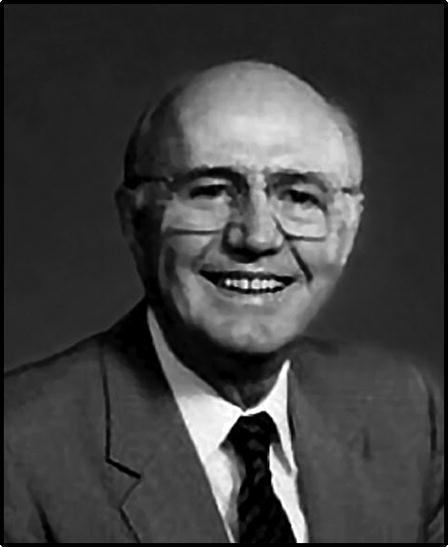Abstract
This biographical sketch draws on articles written by and about one of the most influential orthopedic spine surgeons of our time, Dr. Leon L. Wiltse. Our aim is to commemorate his life and contributions to the fields of orthopedic and spine surgery, while also highlighting his early connections to the Dallas area.
Keywords: Commemoration, military service, orthopedics, spine surgery
Leon L. Wiltse was born on June 27, 1913, in Lisbon, North Dakota.1 As a boy he grew up on the family ranch with eight brothers and two sisters. After graduating from high school in 1931, he matriculated to the University of North Dakota and received his medical degree from Northwestern University 10 years later. During his 3-year orthopedic surgery residency at Charity Hospital in New Orleans, he met and married Dorothy Stenehejm.2
Upon completing his residency and passing the first part of the American Board of Orthopedic Surgery board exam, Dr. Wiltse joined the US Army. Throughout World War II, he served at Walter Reed General Hospital in Washington, DC, as an orthopedic surgeon. Although his time there was relatively short, he made a significant impact, rising to the rank of captain, becoming the institutional chief of orthopedics, and treating Dwight D. Eisenhower in the spring of 1945.3 Having served his country with distinction, Dr. Wiltse was discharged from the army in 1946 to begin his career as a civilian orthopedic surgeon.
Dr. Leon Wiltse first practiced as an orthopedic surgeon in Dallas, Texas. He served on the staff of the W. B. Carrell Memorial Clinic and in the Department of Orthopedics at Baylor University Medical Center. He also began his lifelong passion for academic medicine and mentorship as a faculty member at the University of Texas Southwestern Medical School, before moving to Long Beach, California, in 1948.4 He remained there for the rest of his career. Dr. Wiltse set up his private practice at Long Beach Medical Center and eventually founded the Wiltse Spine Institute (Figure 1).
Figure 1.

Leon Wiltse, 1913–2005. From “Spine Hall of Fame Biographies,” 2017.6
In addition to innovative patient care, Dr. Wiltse was an accomplished author and contributor to the field of spine surgery, producing over 150 publications in the course of his career. His widely distributed works pioneered the diagnosis and treatment of spinal disorders. Most notably, Dr. Wiltse was the first to use methyl methacrylate to secure bone to different spine implants. He also developed a classification system for spondylolisthesis (i.e., abnormal shifting of spine segments) that is still used today and wrote treatises about “the far lateral syndrome.”1,5 He invented the Wiltse spine pedicle screw fixation system and developed a unique tissue-sparing paraspinal approach of the lumbar spine, which greatly improved patient outcomes and significantly reduced recovery periods. The eponymously named “Wiltse approach” is performed for many minimally invasive and open surgeries to this day.1
Dr. Wiltse’s dedication to the advancement of orthopedics was not limited to his research discoveries. From 1971 to 1993, he mentored over 40 burgeoning spine surgeons through the Wiltse Fellowship in Medicine and Surgery of the Spine. There are now four generations of Wiltse spine fellows.5,6 Dr. Wiltse’s active membership in surgical societies such as the American Academy of Orthopedic Surgeons, Western Orthopedic Association, and American Orthopedic Association also ensured the spread of knowledge and wisdom that he amassed over the years. Furthermore, he served as president of many other spine and orthopedic associations, including Société Internationale de Chirurgie Orthopédique et de Traumatologie (American Section) and the Association of Bone and Joint Surgeons. Most notably, Dr. Wiltse founded both the International Society for the Study of Lumbar Spine and the North American Spine Society. He retired in 1993, but his devotion to teaching and mentorship has not gone unnoticed. Each year, the North American Spine Society honors a distinguished mentor during the Leon L. Wiltse Award Ceremonies for the best paper presented.5
In conclusion, Dr. Leon L. Wiltse’s pioneering work shaped the practice of modern spine surgery (Figure 2).5 In 2003, his contributions to medicine were honored through the construction of the Leon Wiltse Memorial Hospital in Seoul, South Korea.4,5,7 On December 19, 2005, Dr. Wiltse passed away peacefully at the age of 92 in Carmel, California. He and his wife are survived by their three children, two grandchildren, and two great-grandchildren.7 His selfless leadership touched the lives of countless patients across the globe. He inspired physicians everywhere to practice medicine ethically, prioritize learning from failures, and spread kindness. During his 1994 address at the 9th Annual Meeting of the North American Spine Society, Dr. Wiltse’s core virtue of selflessness was made clear: “In our work, we must do what the best in our profession have always done: (1) put the patient first; (2) put the community and society second; (3) put ourselves last.”2
Figure 2.

Leon Lamont Wiltse. Photo: Geraldine Laybourne.
References
- 1.Rapp A, Shah M, Tkachenko L, Moisi MD, Tubbs RS.. The paraspinal Wiltse approach to the lumbar spine: a literature review and anatomical guide. Spine Sch. 2017;1(2):108–114. doi: 10.26632/ss.11.2017.1.2. [DOI] [Google Scholar]
- 2.Wiltse LL. My first 80 years: NASS presidential guest speaker address. Spine. 1995;20(16):1751–1760. doi: 10.1097/00007632-199508150-00002. [DOI] [PubMed] [Google Scholar]
- 3.American Academy of Orthopaedic Surgeons . Legacy of heroes. http://legacyofheroes.aaos.org/About/Heroes/stories/wiltse.cfm. Published April 20, 2003. Accessed December 30, 2020.
- 4.In memoriam. Proc (Bayl Univ Med Cent). 2006;19(2):131. doi: 10.1080/08998280.2006.11928146. [DOI] [Google Scholar]
- 5.Fredrickson BE, Yuan HA, Leon L, Wiltse MD.. Leon L. Wiltse, MD. Spine J. 2006;6(2):211. doi: 10.1016/j.spinee.2006.02.001. [DOI] [Google Scholar]
- 6.Spine Hall of Fame Biographies . The Burton Report. https://www.burtonreport.com/infspine/hallfamebiosii.htm. Published April 30, 2016. Accessed June 2, 2020.
- 7.Leon Wiltse—Obituary. https://www.legacy.com/amp/obituaries/lbpresstelegram/16058943. Published December 22, 2005. Accessed October 23, 2020.


